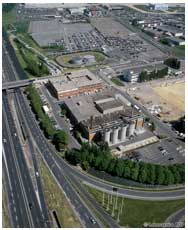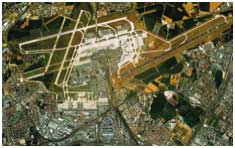Main MenuProductsPartners |
 Electricity is one of the factors that must be managed as a matter of priority if one wishes to optimise the way an airport functions and address the vital challenges of this type of structure. In order to attain this crucial safety objective, the Orly electrical power plant recently underwent a full overhaul, which was completed in 2004. During the preparatory stage of the overhaul, a set of specifications was drafted. One of the essential conditions of the project was the provision of a remote alarm system. Having conducted a study to determine the product most suited to the plants specific scenarios, Alert was the solution finally selected. The airport also opted to couple the Alert alarm management software to the PCVue monitoring system. The power plant consists of 2 10-Megawatt turbines, which supply the commercial power grid, and 3 diesel units with a power output of 1500 kW, used for operational purposes and A.N.A. (Air Navigation Aids): air traffic control, runway lighting and radio navigation. The plants tasks include power production and distribution, as well as the repair, maintenance and control of the power grid. Alert, banking on the zero-risk principleThe plant is responsible for all matters relating to the electricity supplied by EDF, but must also be capable of covering energy requirements in the event of a failure on the part of EDF (20,000V!). In theses case, we talk about emergency backup. The switch from EDF power, should it fail, to backup power must fulfil one crucial condition: an uninterrupted supply of power to all ANA-related systems. Faced with this implacable need for continuity, the various players involved have no margin for error. The assistance provided by Alert when combined with PCVue offers great peace of mind and is a key factor in the success of these extreme emergency procedures.
Alert also makes it possible to monitor the variables that govern the quality of the electrical grid, as well as power distribution and safety: short circuits, grounding faults, voltage drops, surges or interruptions, unknown flows ? for example the operation of equipment without prior warning, etc. Should an alarm be triggered, a person equipped with a GSM mobile phone, the manager, receives these phone calls in priority. His role is to relay the information, but he also maintains control over its validation and final distribution. By centralising these alarms, he is able to diagnose the degree of urgency and determines the type of solution required. He then either calls the person he believes is most qualified to deal with the situation or takes the required action himself. In the event of an alarm, call attempts are made over 4 stages, ranked in the following order of priority should the previous stage fail: The call consists of a pre-recorded voice message. Upon receiving this call, the recipient must first of all acknowledge the call by pressing a predetermined digit. He can then listen to the various alarms and repeat them as he pleases. In addition, he can acknowledge alarms by group or one-by-one. It is also possible to call back at any time in order to obtain a summary of the incidents begin resolved. Alert: greater mobility, greater effectivenessPreviously, the Orly plant mainly operated using a system comprising warning lights and audible alarms. The system compromised the effectiveness of its operators for two reasons. On one hand, the fixed nature of the system forced them to remain in the control room in case an alarm was triggered. On the other, the information they received was incomplete: they knew there was a problem at a specific location, but they were not always able to determine the exact nature of the fault. Alert includes as much detail as possible in the information it sends through to operators. They can now gather detailed information on the following locations in particular: High-voltage busbar connections, diesel units/turbine and transformers (temperature and fluid leaks). Thus, thanks to the assistance provided by Alert and PCVue, employees at the plant now enjoy greater mobility, which allows them to cover the sector in an optimal fashion, while remaining reachable at all times. Repair work is also better distributed and more effective because operators can obtain information on the exact nature of the fault. On top of all this, Alert was also easy to install, because it relieved the user of the need to redefine all the information already set up in PCVue. They were able to simply import the database already entered in PCVue, thus saving precious time and rationalising their installation more quickly once it had been coupled. |
References
Support |



 Thanks to this accessibility, operators can still reach the central control room promptly and this mobility does not cut them off from their base. Greater movement is therefore not incompatible with the visits they are required to make to the control room, which remains the rallying point for internal procedures.
Thanks to this accessibility, operators can still reach the central control room promptly and this mobility does not cut them off from their base. Greater movement is therefore not incompatible with the visits they are required to make to the control room, which remains the rallying point for internal procedures.